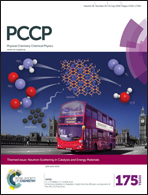Theoretical study on mechanism of the photochemical ligand substitution of fac-[ReI(bpy)(CO)3(PR3)]+ complex†
Abstract
The mechanism of the CO ligand dissociation of fac-[ReI(bpy)(CO)3P(OMe)3]+ has theoretically been investigated, as the dominant process of the photochemical ligand substitution (PLS) reactions of fac-[ReI(bpy)(CO)3PR3]+, by using the (TD-)DFT method. The PLS reactivity can be determined by the topology of the T1 potential energy surface because the photoexcited complex is able to decay into the T1 state by internal conversions (through conical intersections) and intersystem crossings (via crossing seams) with sufficiently low energy barriers. The T1 state has a character of the metal-to-ligand charge-transfer (3MLCT) around the Franck–Condon region, and it changes to the metal-centered (3MC) state as the Re–CO bond is elongated and bent. The equatorial CO ligand has a much higher energy barrier to leave than that of the axial CO, so that the axial CO ligand selectively dissociates in the PLS reaction. The single-component artificial force induced reaction (SC-AFIR) search reveals the CO dissociation pathway in photostable fac-[ReI(bpy)(CO)3Cl]; however, the dissociation barrier on the T1 state is substantially higher than that in fac-[ReI(bpy)(CO)3PR3]+ and the minimum-energy seams of crossings (MESXs) are located before and below the barrier. The MESXs have also been searched in fac-[ReI(bpy)(CO)3PR3]+ and no MESXs were found before and below the barrier.
![Graphical abstract: Theoretical study on mechanism of the photochemical ligand substitution of fac-[ReI(bpy)(CO)3(PR3)]+ complex](/en/Image/Get?imageInfo.ImageType=GA&imageInfo.ImageIdentifier.ManuscriptID=C6CP02314B&imageInfo.ImageIdentifier.Year=2016)

 Please wait while we load your content...
Please wait while we load your content...